Instructional Design for Science Teachers: Using the Idea of Models for Concepts to Drive Learning
- Nathan Belcher
- Feb 13
- 13 min read
How does a teacher organize instruction to maximize student learning?
This question has been important for the entire time humans have taught each other:
Early humans learning survival skills;
Later humans learning a trade; and,
Current humans learning through courses.
Although people can learn on their own, learning is accelerated with the help of other people. However, the amount of learning changes depending on the instructional design, making the instructional design for learning important.
No matter the topic for learning, poor instructional design leads to confusion and minimal learning — whereas excellent instructional design leads to robust understanding and maximized learning.
As with every subject area in formal schooling in the United States, science education has evolved over the years:
First efforts were the creation of high schools in the late 1800s;
Next efforts were the work the scientists in the classroom in the 1950s; and,
Current efforts are the Next Generation Science Standards.
Each effort built on previous work, with the work representing the best thinking of the scientific and science education communities.
As a teacher with 10 years of experience — and an action research project on my teaching, leading to a Doctor of Education degree — I have experimented with different instructional designs. I have come to believe that instructional design flows from ideas about learning; without a fundamental idea of how humans learn, there can be no consistent instructional design.
This guide has three parts:
A discussion on idea of mental models as the foundation for learning.
A formal definition a scientific model for a concept.
An instructional design that uses models for concepts as the basis for instruction.
By following this guide in your science class, you will provide students with an opportunity to have a robust understanding of the concepts and maximize their learning.
Basics of Learning
Before designing instruction, teachers should have an understanding of the basics for how humans learn. The principles for how humans learn lead to specific practices for instructional design — allowing you to structure the science course for maximum learning.
Models for Concepts
A model for a concept [1] can be defined as “a set of organized schemata for a concept that can be used to explain parts of the concept or predict outcomes from the concept.”
The foundational idea for how we organize information comes from Jean Piaget’s learning theory of Cognitive Constructivism. Piaget proposed that humans construct their own understanding of the world, creating a schema for everything they learn; a schema is defined as the “basic unit of knowledge that relates to all aspects of the world.” Related schemata (the plural of schema) can be combined into a model for a concept.
Both parts of the definition for a model for a concept are important:
The model for a concept explains the schemata and the relationships between the schemata.
Using the schemata and relationships between the schemata, the model for a concept predicts outcomes in the imagined or real world.
To test the predictions of the model for a concept, you apply the model in a situation and see the outcome. Faulty explanations of the parts in a model will result in poor predictions, leading to poor outcomes. However, we use the outcomes to change the explanations in a model — leading to better outcomes and a more complete model.
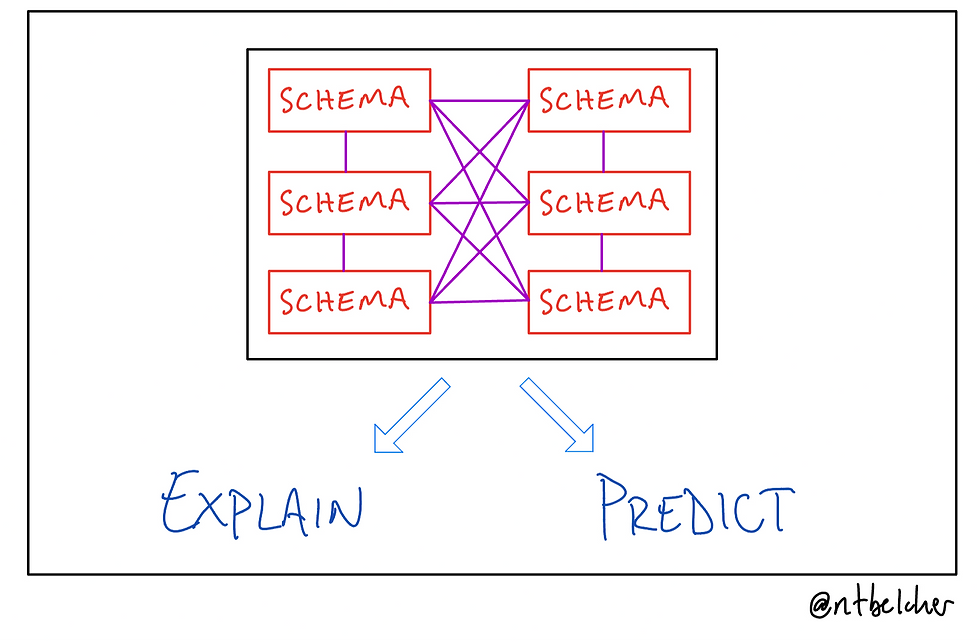
Learning
Although there are many definitions of learning, let’s use this definition: “Learning is the process of creating, modifying, linking, and applying models for concepts.”
This definition of learning flows from our definition of a model for a concept: All pieces of information our bodies and brains collect and process are encoded in mental models. These pieces of information are used in four ways:
Create a new mental model.
Modify an existing mental model.
Link multiple mental models.
Apply a mental model.
Each of the four ways changes our current models for concepts — leading to a deeper understanding within a concept and making connections across concepts.
(For a more in-depth explanation of learning, read my article titled That’s How Learning Works?!?! A Comprehensive Model for Understanding the Learning Process.)
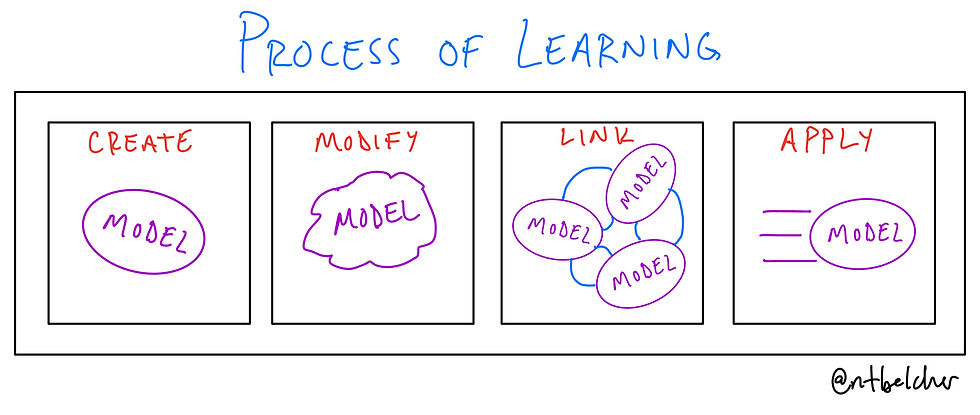
Models in Science
The knowledge and skills humans call “science” is the entire set of individual models for concepts within defined topics.
A model for a concept is created from individual models: Different people have their own personal model about a concept; through discussion, people come to an agreement about the important parts of the model for a concept. After consensus is reached by the individuals — using the best available data to explain the concept and predict outcomes from the concept — the scientific community accepts the model for a concept.
Every model for a concept is always subject to revision; if the model for a concept cannot account for new data, the model must be updated.

Every science course teaches specific models for concepts — the goal of the science course is for students to develop a strong understanding of each model for a concept in the course.
Students informally study the natural world as they develop, forming ideas about how the world works [2]. These ideas create a model for a concept, but the student’s model for a concept may or may not match the scientific community’s model for a concept. As students progress through science courses, students use (age-appropriate) laboratory activities, discussion, and practice to refine their model for a concept — eventually matching their model for a concept with the scientific community’s model for a concept.
By repeating this process throughout courses in different science disciplines, students develop a strong understanding of models for concepts — becoming ready to contribute to the scientific community.
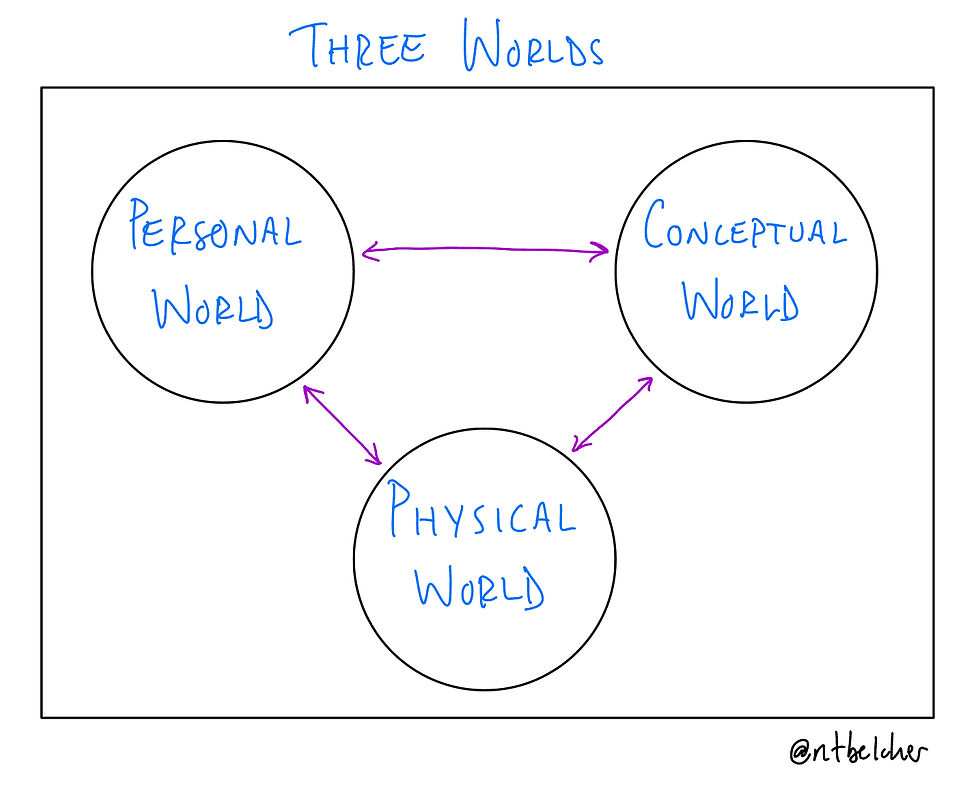
With an understanding that “science” is made of many models for concepts, we need to define a scientific model for a concept.
Fortunately, science educators [3] have done the work to identify the structure of scientific models for concepts. Every scientific model for a concept can be described by these categories:
Written/Verbal Statements — Important explanatory and predictive statements about the concept
Mathematics — Equations for the concept
Graphs — Visual relationships in the concept
Diagrams — Visual representations of physical parts in the concept
Applications — Uses of the ideas in the concept
Limits — Ways that the model’s explanations and predictions fail
Specific models for concepts in different scientific disciplines may have an emphasis on different parts of the model, but every model for a concept will have at least one item in each category.
To organize the model for a concept, students are given a paper with the six categories — known as a “model sheet.” This paper serves as a physical embodiment of their mental model, allowing students to see their current understanding of the model for a concept.

Instructional Design
With the information on learning and models in science, we can now return to the question at the beginning of this article: How does a teacher organize instruction to maximize student learning?
Step 1 — Organize Information in Curriculum into a Model for a Concept
Using your curriculum, organize information in a specific standard (or set of standards) into a model for a concept.
For teachers whose (American) states adopted the Next Generation Science Standards or a similar set of standards, use the Disciplinary Core Ideas (DCIs) for your course. Each DCI gives specifics for the information in the standard, including boundaries for the depth and breadth of the standard. The Crosscutting Concepts (CCCs) can be either added in the “Written/Verbal Statements” of the appropriate model for a concept or as their own model for a concept; no matter which way the CCCs are included, they must be part of the models for concepts in the science course [4].
After organizing information into a model for a concept, figure out the order for the information:
What information is foundational for the rest of the information and should be taught first?
What information comes next, building from the first information?
What information is taught last, finalizing the model for a concept?
Answering these questions — combined with Step 2 — will help you create your instructional plan in Step 3.
The goal is to get students to write complete model for a concept from memory onto a blank sheet AND apply the model to novel situations.
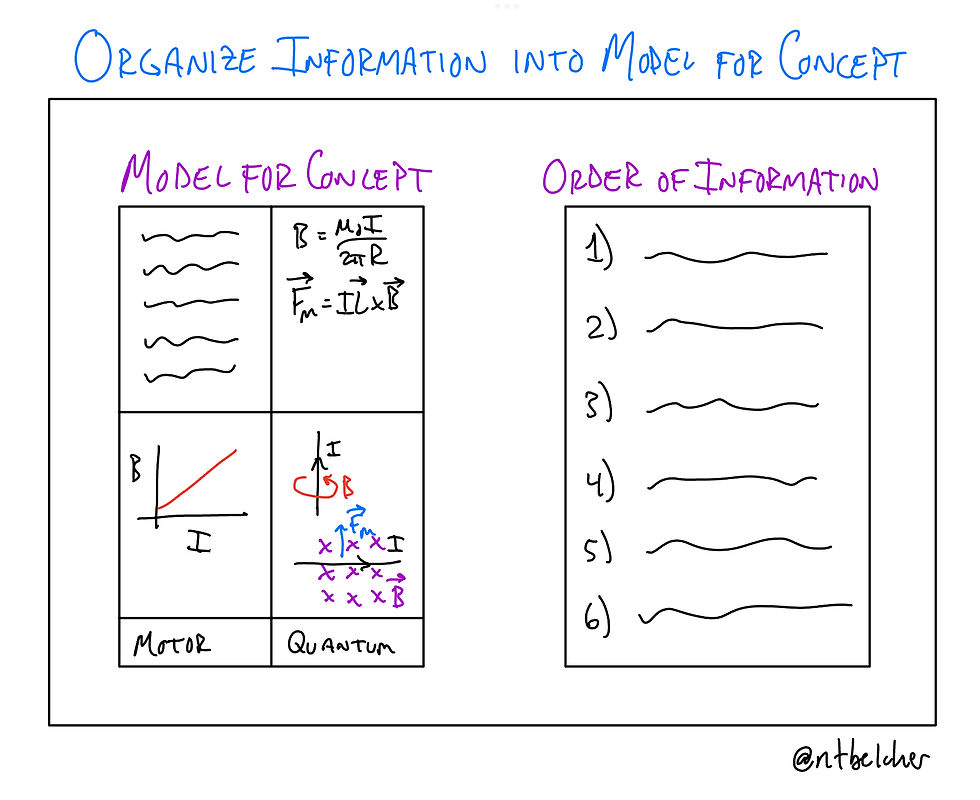
Step 2 — Organize Tasks
Instructional design for science courses has different tasks: Activity, discussion, practice, model, and assessment. Each task has a specific purpose, leading students to develop a complete model for a concept.
Activity is laboratory work, either hand-on or computer-based. Activities can be performed several ways:
Discovery: These activities have students collect data, graph, and perform analysis to determine a relationship between two variables.
Verification: These activities have students verify a previously-studied relationship between two variables.
Claim-Evidence-Reasoning: These activities have students make a claim about a situation, gather evidence about the claim, and provide reasoning about the veracity of the claim.
Each activity type is important, but choosing the way to perform an activity depends on the the placement of the activity within the instructional cycle. (This will be further explained in Step 3.)
Discussion is an information-and-question session about ideas in the model for a concept. This can be done in-class or as a video, using appropriate delivery techniques. For an in-class session, the information delivery should not be a lecture; rather, the information should be chunked, with embedded questions for personal reflection and group discussion. For a video session, the information should also be chunked — with pauses within the video for students to write questions and reflect on the information. Both types of session should clarify and extend the model for a concept, helping students develop their model for a concept.
Practice is any explanation or application of a model for a concept, ranging from simple, familiar situations to complex, novel situations. There are many ways to practice, including these:
Graphing data from a given data set, then interpreting and using the function of best fit.
Creating or interpreting diagrams for a situation.
Using equations to solve for a specific variable or number.
Building physical items that perform a task.
Using coding software — either command-line or no-code — to create a simulation.
Writing to explain parts of the concept or make predictions from the concept.
Practice can be conceptual or specific, but should have a clear progression from easy to hard. In addition, practice should always point back to the model for a concept, helping students make and verify predictions from the model for a concept. (For a more in-depth look at practice, read my article titled Stuck in a Performance Plateau?.)
Model is creating a model for a concept by completing the paper with six categories. The initial model creation happens after the first activity in the instructional cycle; however, this model will be incomplete. As students work through the instructional cycle, they gain more information in their model for a concept — finishing the instructional cycle with a complete model for a concept. This information should be in their memory by the end of the instructional cycle, allowing students to write the complete model for a concept from memory and apply the model for a concept to novel situations.
Assessment is a formalized version of practice. Practice and assessment are the same idea, but the results from an explanation or application of a model for a concept that is labeled “assessment” goes into the scorebook. Every opportunity for practice is a chance for self-assessment; every assessment is an opportunity to practice. There are many ways to assess, including the methods listed in the practice section. In the same way as practice, assessment can be conceptual or specific, simple or complex. Choices regarding the details of assessments will be specific to your teaching situation, but the assessments should always make students explain or apply one or more the models for concepts.

Step 3 — Schedule Tasks to Create an Instructional Plan
With the definition of each task, we can now combine tasks into an instructional plan.
The ideas in this instructional plan are a combination of the BSBC 5E Method, phenomena-based methods, and the AMTA Modeling Cycle — with emphasis on developing and using a model for a concept. In addition, Priya Parker’s ideas from The Art of Gathering are used to figure out what parts are most important to do in-person and which parts can be done by students outside of class. The tasks in each class are modular, meaning that the tasks can be shortened or lengthened according to your amount of class time and students.
Instructional Plan
Part 1: Every concept begins with a phenomena — ideally this phenomena is a hands-on discovery activity task, but the phenomena will depend on the concept. This phenomena is used to give students practice with the process of science — as outlined by the SEPs:
Creating questions by asking “What is happening?”
Gathering data (if applicable to the phenomena) by asking “What can we measure?”
Performing qualitative or quantitative analysis to develop a basic understanding of the phenomena by asking “What can we conclude?”
After finishing the activity, students do the model task and complete a model sheet for the information in the activity. This is the initial model for a concept, which will be developed through the rest of the instructional plan.
Part 2: Students receive more information about the concept through the discussion task, either out-of-class or in-class. Using appropriate delivery techniques, students have time to receive and consider the information — then discuss and reflect with peers. Students update their model sheet with the new information (model task), organizing the information into one of the six categories.
Part 3: With enough information to in the model for a concept, students are ready to do parts of the practice task. Practice begins with simple and familiar scenarios, then progresses to more complex and novel scenarios. Practice also has these characteristics:
Spacing and interleaving of models for concepts.
Pushing students outside their comfort zone, making them exert meaningful effort.
Feedback on the outcome of the practice happens quickly.
Practice exposes the depth of a student’s understanding of a model for a concept, allowing them to see gaps in their model for a concept. Throughout practice, students update their model for a concept (model task) — gaining a deeper understanding of the concept. Note: During this part, teachers can use any part of the assessment task — especially if using no- or low-stakes items.
Part 4: Using information from their model, students perform a verification or CER activity. This activity continues students’ understanding of the process of science (as outlined by the SEPs) — and allows students to use their model for a concept to make predictions. After finishing the activity, students update their model sheet with new information (model task).
Part 5: By completing the activities, discussion, and practice, students should be close to a completed model for a concept. To further solidify the model for a concept (based on student needs), the teacher and students have many choices:
Discussion to compare and contrast parts of the currently-studied model for a concept with other models for concepts.
More practice on the model for a concept, with practice that has the same surface characteristics but different deep characteristics (SSDD) or different surface characteristics but same deep characteristics (DSSD).
Demonstrations to show the application and limits of the model for a concept — especially demonstrations that are counterintuitive.
More activities to apply the model for a concept.
After completing any of these choices, students update their model sheet with new information (model task).
Part 6: The instructional plan finishes with an assessment, allowing students to show their learning of the model for a concept. This assessment can take many forms — depending on the teacher’s assessment system — but the assessment should include multiple parts of the model for a concept.
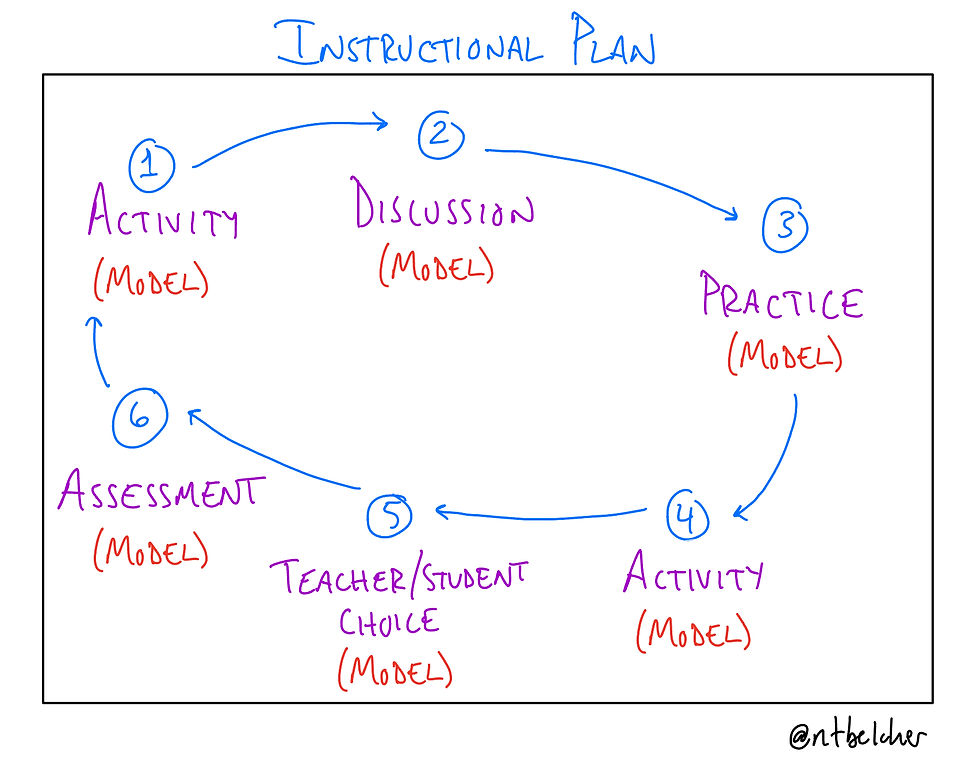
After completing these six parts, begin the process again with a different model for a concept.
The instructional plan usually takes 10 to 15 classes (with 80-minute classes) for a model for a concept in a first-year course. This amount of classes gives six to eight models for concepts throughout the entire class, depending on the complexity of the models for concepts. The instructional plan is much quicker for certain models for concepts in a second-year course; because students have foundational knowledge, skipping certain parts in the instructional plan is appropriate.
Examples of Complete Models for a Concept in AP Physics C:
Model for Constant Linear Velocity
Model for Uniform Linear Acceleration


Summary
Instructional design plays an important role in education, creating the conditions to learn (or not) about a concept.
Poor instructional design leads to confusion and minimal learning — whereas excellent instructional design leads to robust understanding and maximized learning.
By aligning ideas about mental models and learning, scientific models for a concept, and an instructional design for learning, you can help your students have a robust understanding and maximum learning about the models for a concept!
Next Actions
Now that you know have a guide for instructional design in science courses, here are some questions to consider:
How do you define learning? How does this affect your instructional design?
How do you define “science”? How does this affect your instructional design?
Is your instructional design similar to the one in this article? Are there parts of the instructional design in this article that would be useful to incorporate into your instructional design?
Let me know your answers to any of these questions by completing a message in the "About" section of this website; I would love to hear from you!
Notes
[1] From Gouvea and Passmore (2017), the idea of a model for a concept (versus a model of a concept) is important. The word of implies that the model simply represents the characteristics of the concept; this is useful, but ultimately limits learning about the concept. In contrast the word for implies that the concept has a purpose — leading to a full explanations and predictions about the concept. Though these simple words seem to be interchangeable, there is a massive philosophical difference between “of” and “for.” If you are interested in the nuances of the words “of” and “for,” I highly recommend Gouvea and Passmore’s paper!
[2] At the time of publication, my wife and I have two small children. The learning by our children as they explore the world is fascinating, giving us a better appreciation for how humans learn.
[3] The foundation of a model for a concept can be traced to the work of the American Modeling Teachers Association [INSERT LINK]. The organization has outstanding curriculum for many science disciplines, aligning to the Next Generation Science Standards and principles of learning.
[4] One way to think about science is two parts: One part is the information in science; the other part is the process of science. The information in science is given through the DCIs and CCCS, whereas the process of science is given by the Science and Engineering Practices (SEPs). The SEPs are a crucial part of any science course — deserving instruction and practice — and form the foundation of a model for a science experiment. The model for a science experiment has a different structure than a model for a concept, which will be discussed in a future article.
References
American Modeling Teachers Association. Retrieved from https://www.modelinginstruction.org
BSCS Science Learning. Retrieved from https://bscs.org
Gouvea, J., & Passmore, C. (2017). ‘Models of’ versus ‘models for.’ Science & Education, 26(1-2), 49–63. https://doi.org/10.1007/s11191-017-9884-4
Hestenes, D. (2006). Notes for a modeling theory of science, cognition and instruction. Proceedings of the 2006 GIREP Conference.
McKenna, T. J. Phenomena for NGSS. Retrieved from https://www.ngssphenomena.com/
Next Generation Science Standards. Retrieved from https://www.nextgenscience.org/
Parker, P. (2018). The art of gathering: Create transformative meetings, events and experiences. Portfolio/Penguin.
University of California, Berkley. (2016). Learning: Theory and research. Teaching Guide for GSIs. Retrieved from http://gsi.berkeley.edu/media/Learning.pdf
Vinney, C. (2019, July 22). What is a schema in psychology? definition and examples. ThoughtCo. Retrieved from https://www.thoughtco.com/schema-definition-4691768




Comments